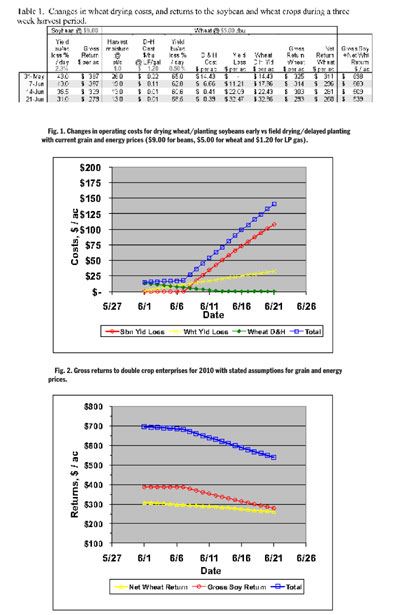Cost Trade-Offs For Drying Wheat And Planting DC Soybeans
PRINCETON, KY.
An early May survey of local cash prices for wheat and soybeans showed current levels at $5.00 and $9.00/bu, respectively, which are similar to last year’s prices for both crops. Energy prices are also near the same level as last y ear with LP gas around $1.20 per gallon, so drying costs will also be similar and double crop farmers are pondering this information as they try to decide whether it’s better to harvest wheat early and dry it with LP gas so that soybeans can be planted earlier to achieve their maximum yield potential…OR…is it better to let the wheat dry in the field and delay soybean planting a few days. To help put some numbers to that decision, a spreadsheet was developed that takes into account grain and energy prices along with a few other related factors. Together they can be used to calculate gross profits from the soybean crop and net returns to the wheat enterprise after subtracting out drying costs.
For both crops, the spreadsheet uses yield, price and yield loss per day. For wheat, a field drying rate is also assumed in addition to the price of LP gas to calculate the drying cost as the harvest season progresses. Of course, towards the end of the harvest season, wheat will be dry enough to avoid a drying charge, but by that time soybean yields will have fallen off dramatically.
To run thru an example, consider a situation in the mid-South where the optimum harvest date is June 7…although we would want to start harvest a few days earlier to work through that optimum date. With the grain and energy prices mentioned earlier, average yields of 43 bu/ac for soybeans and 65 for wheat, a daily soybean yield loss of 2.3 percent for delayed planting, a wheat yield loss of 0.5 percent for each day that harvest is delayed, and a wheat moisture level of 26 percent, the drying and handling cost would be about 22 cents per bushel (or $14 per acre) but the gross returns would be $325/ac for wheat and $387 for soybeans, which combine for ~$698 after paying for drying, as shown in Table 1. Each row in the table shows how these costs and returns change through a three week harvest period.

Data in the table are shown in more detail in Figure 1, where daily changes in soybean and wheat yield losses, wheat drying and hauling and the total of these costs are illustrated. Corresponding net returns for wheat harvest and gross returns for the soybean crop are shown in Figure 2, where loses average about $2 per acreday before the optimum harvest data and increase to about $10/ac for each day soybean planting is delayed afterward! For these reasons, more farmers may be interested in drying wheat this spring to boost soybean yields and net profits. More information on wheat drying and this spreadsheet is available at UK Cooperative Extension Service offices or by searching for grain storage on the College of Agriculture website (www.ca.uky.edu). Δ
DR. SAM MCNEILL: Extension Agricultural Engineer, University of Kentucky